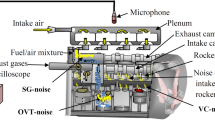Abstract
The sound quality evaluation model based on complementary ensemble empirical mode decomposition (CEEMD), Hilbert transform (HT) and relevance vector machine (RVM) is proposed to predict the sound quality of acoustical signals at power coupling mechanism of a hybrid electric vehicle (HEV). The technique is applied with wave filtering and CEEMD of the acoustical signals acquired at power coupling mechanism of HEV to achieve the intrinsic mode function (IMF) components. Built upon this is the calculation of the instantaneous frequencies of the IMF components by HT. Then, the critical frequency bands are used as the weight to calculate the weighted energy values of the IMF components. The weighted energy values are used as the new inputs of the sound quality evaluation model. Afterward, the subjective evaluation experiment of the acoustical signals at the power coupling mechanism is carried out based on pairwise comparison method. The subjective evaluation values are used as the outputs of the evaluation model. Finally, the new evaluation model is established based on RVM. In addition, the second RVM model is built for sound quality evaluation with the psychoacoustic objective parameters as the inputs. In this paper, the sound samples acquired under steady- and unsteady-state operating conditions are tested, respectively, in two models to obtain the prediction results. The prediction result suggests that the prediction accuracy of the evaluation model based on CEEMD-HT is higher than the evaluation model based on psychoacoustic objective parameters, and the prediction accuracy of the steady sound samples is higher than the unsteady sound samples.




Similar content being viewed by others
Data availability
The data used to support the findings of this study are included within the article.
References
Lim DJ, Jahromi SR, Anderson TR, Tudorie AA (2015) Comparing technological advancement of hybrid electric vehicles (HEV) in different market segments. Technol Forecast Soc Chang 97:140–153
Zhou WJ, Zuo YY, Zheng MY (2018) Analysis and optimization of the vibration and noise of a double planetary gear power coupling mechanism. Shock Vib 2018:1–13
Anders G, Daniel V (2013) Experience and information content affect interior vehicle sound quality assessments. Int J Veh Noise Vib 9(1):47–60
Soeta Y, Shimokura R (2017) Sound quality evaluation of air-conditioner noise based on factors of the autocorrelation function. Appl Acoust 124:11–19
Liu H, Zhang J, Guo P, Bi F, Yu H (2015) Sound quality prediction for engine-radiated noise. Noise Vib Bull 56–57:277–287
Kim EY, Shin TJ, Sang KL (2013) New tonality design for non-stationary signal and its application to sound quality for gear whine sound. Proc Inst Mech Eng, Part D: J Automob Eng 227(3):311–322
Kang HS, Cho HY, Shin T, Lee SK, Shon JH (2015) Objective evaluation of the pulling sound for a seat belt in a vehicle. J Noise Control Eng 63(4):370–383
Liu ZW, Liang J, Wang SG, Jiang JG (2006) Subjective evaluation test and objective quantificational description of vehicle interior noise quality. J Jilin Univ (Eng Technol Edition) S2:41–45
Ulas HB, Ozkan MT, Malkoc Y (2019) Vibration prediction in drilling processes with HSS and carbide drill bit by means of artificial neural networks. Neural Comput Appl 31:5547–5562
Huang HB, Li RX, Yang ML, Lim TC, Ding WP (2017) Evaluation of vehicle interior sound quality using a continuous restricted Boltzmann machine-based DBN. Mech Syst Signal Process 84:245–267
Huang NE (1998) The empirical mode decomposition and the Hilbert spectrum for nonlinear and non-stationary time series analysis. Pric R. Soc 454:903–905
Wu ZH, Huang NE (2009) Ensemble empirical mode decomposition: a noise-assisted data analysis method. Adv Adapt Data Anal 1(1):1–41
Bi FR, Ma T, Zhang J, Li L, Shi CF (2016) Knock detection in spark ignition engines base on complementary ensemble empirical mode decomposition-Hilbert transform. Shock Vib 2:1–17
Zwicker E (1961) Subdivision of the audible frequency range into critical bands (frequenzgruppen). J Acoust Soc Am 33(2):248–248
Mao DX, Gao YL, Yu WZ, Wang ZM (2005) Grouped pair-wise comparison for subjective sound quality evaluation. Acta Acust 30(6):515–520
Ma C, Li Q, Deng L, Chen C, Liu Q (2017) A novel sound quality evaluation method of the diagnosis of abnormal noise in interior permanent magnet synchronous motors for electric vehicles. IEEE Trans Ind Electron 64(5):3883–3891
Ishiyama T, Hashimoto T (2000) The impact of sound quality on annoyance caused by road traffic noise: an influence of frequency spectra on annoyance. JSAE Rev 21(2):225–230
Tipping ME (2001) Sparse bayesian learning and the relevance vector machine. J Mach Learn Res 1(3):211–214
Chang MH, Kang M, Pecht M (2017) Prognostics-based LED qualification using similarity-based statistical measure with RVM regression model. IEEE Trans Ind Electron 64(7):5667–5677
Blauert J, Braasch J, Raake A (2017) Tools for the assessment of sound quality and quality of experience in original and simulated spaces for acoustic performances. J Acoust Soc Am 141(5):3932–3932
Mao DX, Yu WZ, Wang ZM (2005) Statistical validation criterion for paired comparison data in sound quality evaluation. Acta Acust 30(5):468–472
Liu B, Wan JQ, Huang MZ, Ma YW, Wang Y (2015) A PCA-LSSVM model for on-line prediction of the effluent VFA in an anaerobic wastewater treatment system. Acta Sci Circumst 35(6):1768–1778
Acknowledgements
The authors are grateful to the financial support provided by the National Natural Science Foundation of China (No. 51575238) and the Natural Science Foundation of Jiangsu High Education Institutions of China (No. 18KJB580001).
Author information
Authors and Affiliations
Corresponding author
Ethics declarations
Conflict of interest
The authors declared that they have no conflict of interests regarding the publication of this paper.
Additional information
Publisher's Note
Springer Nature remains neutral with regard to jurisdictional claims in published maps and institutional affiliations.
Electronic supplementary material
Below is the link to the electronic supplementary material.
Rights and permissions
About this article
Cite this article
Lu, Y., Zuo, Y., Wang, H. et al. Sound quality prediction for power coupling mechanism of HEV based on CEEMD-HT and RVM. Neural Comput & Applic 33, 8201–8216 (2021). https://doi.org/10.1007/s00521-020-04934-3
Received:
Accepted:
Published:
Issue Date:
DOI: https://doi.org/10.1007/s00521-020-04934-3




